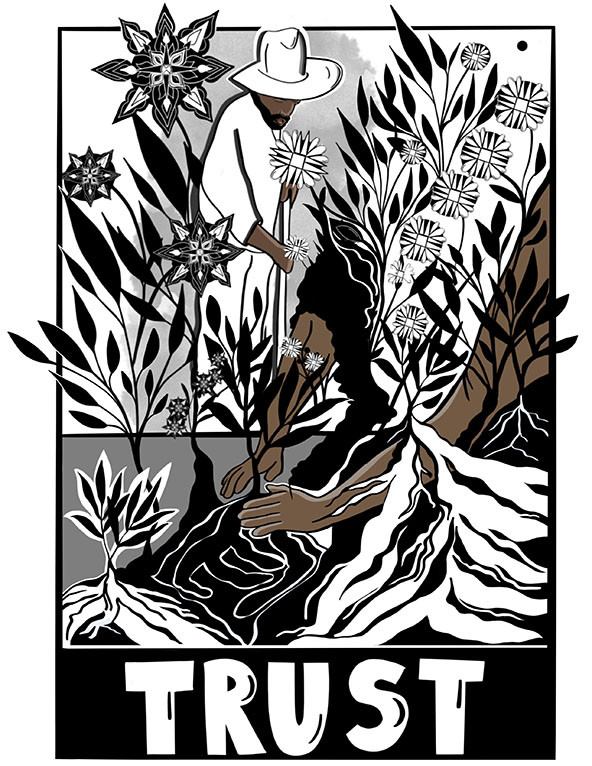 (Illustration by Taslim van Hattum)
(Illustration by Taslim van Hattum)
Over the last decade, philanthropy has undergone a sea change. As foundations increasingly acknowledge the centuries of systematic and institutional racism that have led to intergenerational trauma, cycles of poverty, and reduced life expectancies in communities of color, they are working to re-examine philanthropy’s history and reimagine its role. Under the banner of “trust-based philanthropy,” they are striving to redistribute power and resources and embrace self-critical learning, adopting a more holistic approach to problem definition, embracing multi-faceted solutions over a longer time horizon.
The field of philanthropic evaluation is no exception. As evaluation officers, we are interrogating our own beliefs and training. We are questioning the practices of evaluation and research that communities of color have long distrusted and taking up the challenge to experiment with new mindsets, equity-focused evaluation frameworks, and new definitions of accountability that can support the building of power in marginalized communities.

In 2017, the Equitable Evaluation Initiative (EEI) began to push the field of philanthropic evaluation to align our work with the same principles of inclusion and social justice that underlie equity-focused grantmaking. The “Equitable Evaluation Framework” holds that all evaluation work should advance progress toward equity. But adhering to this principle is not straightforward. As the Equitable Evaluation Initiative points out, evaluation practices in philanthropy are grounded in “orthodoxies,” unquestioned ways of thinking that support the structures and practices maintaining inequality. As the very first step in transforming their approaches to evaluation, foundations must therefore question both these tightly-held beliefs about philanthropy and the top-down orientation that underlies them.
As this rethinking process has unfolded, several sticking points and tensions have surfaced around how evaluation officers can advance equity while embracing complexity. This has been difficult because of traditional notions of objectivity, rigor, and validity. As we have been grappling with these questions, The California Endowment (TCE) concluded that our learning and evaluation work cannot and should not be separated from our work to advance health and racial equity through power building. As the Learning and Evaluation team at TCE has explored what it means to practice trust-based philanthropy, we have redefined our relationships with nonprofits and communities as “partnerships,” to take a first step in correcting the power imbalance that has existed historically between funders and grantees. Further, we have an obligation to use the knowledge that we uncover to influence and organize philanthropy to support effective strategies and solutions created by organizers and those most impacted by inequities.
Shifting towards two-way learning and shared decision-making means developing new understandings of “accountability,” and putting aside narrow, academic definitions of validity and rigor, we are reckoning with how we may have perpetuated beliefs and practices that are counter to building power in marginalized communities. Traditional and historical notions of accountability enforce one-way evaluation practices based on a single question: Have our philanthropic investments brought the desired results? This return-on-investment mindset prioritizes quantitative metrics, narrowly defined objectives, and short time frames. It assumes that foundations get to define success. None of this is compatible with the complexity and multi-dimensional and context-specific nature of power building. The traditional approach can even hinder our grantee partners’ progress by redirecting their time and energy away from long-term strategies that can address root causes of structural inequalities.
In moving away from metrics focused on discrete “wins” and other quantifiable results (that may or may not contribute to power building), our challenge becomes one of meaningfully measuring power and detecting if target communities are building more of it. Strengthened infrastructure, more robust community organizing ecosystems, and systems transformation are less visible and harder to capture than highly trumpeted campaigns with discrete wins and scorecards, but they are much closer to what power actually is. As Hahrie Han points out, however, there are further challenges to measuring power. First, power is a multidimensional construct, including both visible manifestations like the ability to set agendas as well as much more embedded aspects, like control over the production of explanatory narratives. Second, the enactment of community power is place-specific, dynamic, and highly contextual, a dynamic interplay among multiple levels of analysis—individuals, organizations, and institutions. Given these challenges, evaluation must operate from the ground up, using inductive approaches to define real-world indicators of increased power.
A critical insight from the Building Healthy Communities initiative has been that community power building is an end in and of itself. Power building and organizing are not just instrumental for policy change but are fundamental to communities’ sense of efficacy for self-determination. This realization has not only forced TCE to reconceptualize power as a worthy investment, but to assess power building as a primary outcome of the initiative.
A critical function of evaluation is supporting the learning and growth of those most impacted by structural inequality. As Building Healthy Communities drove home, when evaluation embraces the principle that people learn best when they co-create the learning process, it can help grantees learn from their mistakes and adapt to changing contexts and political environments without reproducing a teacher-learner hierarchy. The power-building successes that we documented occurred because partners ventured to risk, fail, and learn from successes and setbacks, and then to translate their learning into effective future actions. Non-judgmental review of failures and successes, with continuous involvement of the populations most affected, produced the learning needed to advance more equitable policies and systems and build community power (For more, see “Philanthropic Investment in People Power”). In essence, we practiced “emergent learning,” the ongoing exploration of a locally defined learning agenda through intentional, iterative learning experiments.
 (Illustration by Taslim van Hattum)
(Illustration by Taslim van Hattum)
What does it mean to re-imagine, redesign, and operationalize learning and evaluation not as an adjunct to initiatives that aim to build power but as a power building strategy itself? As TCE fully pivots to investing in power building to advance health and racial equity, the Learning and Evaluation team is adopting a framework guided by the principles and values of trust-based philanthropy, equitable evaluation, and emergent learning. We are examining how causal analysis—an approach to inquiry that explores cause-and-effect relationships—can play a role in understanding not only the “what” and “how” questions but also questions that explore under what conditions certain interventions or strategies work.
Lynn, Stachowiak, and Coffman make a compelling case to the field of philanthropy that causal analysis strengthens the role learning and evaluation can play in building power and pursuing equity. As they argue, we need to experiment with and adopt innovative evaluation methods, going beyond random controlled trials to participatory methods such as most significant change, outcome harvesting, and outcome mapping. This is needed precisely because philanthropy is wrestling explicitly with systemic racism and white supremacy. Since complex cross-reinforcing dynamics make these societal structures resistant to change, we’ll get nowhere unless we embrace deeper learning about cause and effect and then use what we learn to better inform philanthropic decision-making.
As foundations ask deeper questions about the root causes of inequity, and as we tackle upstream drivers of systemic problems with the aim of building the power of communities and people of color, our experience shows that those responsible for learning, evaluation, and strategy in foundations must play a more active role in engaging grantees and members of target communities as equal partners in learning and evaluation: employing relevant, community-defined metrics, analyzing data collaboratively, and drawing out learnings relevant to power building. Information and insights generated with these approaches are what communities lacking power need to strategize effectively and drive the long-term structural changes that will ensure a more just and inclusive democracy.
Support SSIR’s coverage of cross-sector solutions to global challenges.
Help us further the reach of innovative ideas. Donate today.
Read more stories by Hanh Cao Yu.

